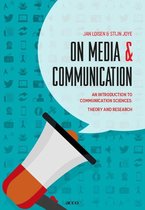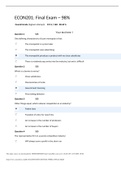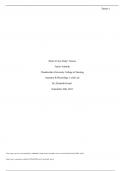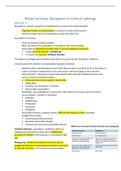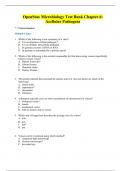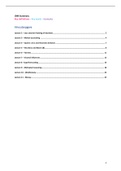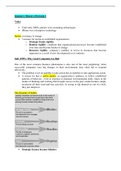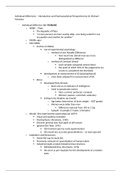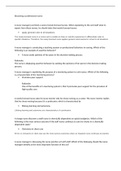An introduction to communication sciences: theory and research
Jan Loisen & Stijn Joye
Chapter 1 | Introduction
Recommended reading
Part I: The history and development of communication sciences and its
theoretical foundations
PART 1: HISTORY AND DEVELOPMENT
Chapter 2 | Prolegomena
Need to know:
- Section 4 (Paradigmatic struggles)
- Section 5 (Central themes)
Recommended reading:
- Section 1 (CS: an academic discipline?)
- Section 2 (CS: young but hard-to-define)
- Section 3 (Common threads)
2. Prolegomena
4. Paradigmatic struggles and theoretical diversity in communication sciences
4.1. The paradigm concept
Paradigm: framework to investigate. Universally shared model by researchers. A methodology
to answer questions.
4.1.1 Paradigms and paradigm shifts
Thomas S. Kuhn: American sciences philosopher, book The structure of Scientific
revolutions: idea that science does not evolve gradually. New knowledge is not generated on a
step-by-step basis, but as a result of sudden and radical change = paradigm shift. Sciences
progress on basis of revolutions. Following elements:
1. Normal science
Can be carried out on basis of dominant paradigm. A paradigm is a coherent system of models
and theories that offers a framework in which reality can be investigated. Universally shared
within discipline’s research community, giving direction to scientific research or:
2. Puzzle-solving
Research operating within well-defined paradigm are generally in agreement about the
essential questions that need (or not) to be addressed, how these questions should be
approached (+which methods), how results should be interpreted (on basis of theories that fit
within paradigm).
3. Paradigm
,Not only common research agenda, methodological approach and theoretical background,
also: deeper-lying fundamental assumptions or: view the world they wish to investigate
through particular ‘coloured’ perspective. Period of ‘normal science’: solution of research
questions and puzzles + refining theoretical and conceptual framework. But: time when
conclusions fail to fit dominant paradigm. E.g. results might contradict theoretical framework
or may expose inadequacy of generally accepted methods. First try dealing with anomalies
withing existing paradigm BUT:
4. Anomaly
Unexpected results will be achieved, things can’t be explained by frameworks and theories that
are being used. Hypotheses that are continuously and increasingly being contradicted. When
anomalies become too frequent: paradigm will enter period of crisis:
5. Crisis
‘extraordinary’ period: different standpoints in conflict. Discussions about fundamental
assumptions increase → other methods, concepts questions are being proposed → new
paradigm: new view of world that clashes with the ruling one → supersedes previous
paradigm. → back to normal science
Incommensurability between 2 paradigms: one replaces other: can’t co-exist, having no
common standards.
6. Paradigm shift
Revolutionary shift heralds in a new period of normal science within new paradigm.
E.g.: Copernican revolution: first general thought: geocentric model: world centre of cosmos
Copernicus heliocentric: sun centre. → studying cosmos from new view: need new questions
and theories. Heliocentric paradigm led to abandonment geocentric paradigm.
4.1.2. Paradigms in social sciences
Competing paradigms: No single dominant paradigm, but a series co-existing. Pendulum-like
process: progression and regression.
4.1.3. Paradigms in communication sciences
4.1.3.1. The dominant mainstream paradigm
- Dominant paradigm
CS 2 paradigms: dominant and alternative. Development dominant paradigm followed by
institutionalization CS in US after WWII. Destined to be: Europe 1940s-1950s: post-war
reconstruction. + US center rise systematic SS research and transformation of media into mass
media. Basic assumptions from 50’s return still today → still ruling paradigm
- World view Liberal Pluralism
US ‘winner’ → underlying Social & human world view, after WWII what we wanted society to
look like: fundamentally liberal and pluralist. Social model characterized by open,
democratically organized, free and inclusive society. In spite of internal contradictions
(rich poor, black white): convinced model was best for entire world. Increasing bipolar
global context Cold War: confirmation opinion
- Liberalism
Communist Soviet Union liberal-pluralist model based on liberalism. Freedom of individual,
fair representation ensured by democratically elected parliament and government that was
subject to the control of judiciary. With press as:
, - Fourth estate
Media: informing citizens and expressing views of different actors and institutions. Intention:
- Consensus
About best way to further develop American society → orderly, structured and consensual
manner. Media not as propaganda (as in war) but as positive contribution to building better
society, ideal model: exemplified US
1950s-1960s: flourishing CS: different trends idealizing world view. E.g.:
- Functionalism
Media as an essential element in the implementation of a number of functions that contributed
to an integrated, positively evolving society. Contributed to normative view on society. Lasswell
first to come up with communication model. Same time:
- Behaviourism
Experiments conducted in behavioural psychology for understanding direct effect of media via
stimulus-response thinking. The senders send something (stimulus) and this generates
response at the destination. Underlying thought, because of linearity: what is intended from
the sender, will be received that way. First paradigm also typified by:
- Information theory
Trying to model the communication process with information theory. First model of Shannon
and Weaver very basic (picture in folder). What’s missing e.g.: feedback loops (meaning very
sender-oriented, as if audience less important), linear, no question on the sender (power,
manipulation, intentions?), not questioning power-relations, no gatekeepers, etc.
- Positivism
Key characteristic beginning of CS: believe in quantitative methods, although actually used in
exact sciences. Believe that media will generate effects on audience and are measurable.
Believe that we can control communication process, which will lead to increase effectiveness
of communication. Ruling questions: how can we reach bigger audience, or a certain kind of
effect? Science must be focused on production of generalizable and reliable knowledge by
means of quantitative and positivist methods, e.g. collection empirical data via
surveys. Thought that science would reveal, assess, and evaluate hidden processes in society.
In spite complexity of:
- Media effects
believed possible to measure effects with scientific instruments so communication could be
increasingly optimized.
Mainstream because: still governs CS at global level. US still epicentre CS: most professional
journals, trendsetting universities and academics are all found there. BUT: in socio-scientific
paradigms room for dissent and:
- Contestation:
Overly focused on effect, although hard to empirically measure/proof effects. Doesn’t take into
account: tensions among groups, crises, etc. noise (unwanted signal that interferes with
original message). WAP interpreted completely different. Filtering and gatekeeping
(controlling and usually limiting general access to something).
4.1.3.2. Criticism and the alternative critical paradigm
- Critical paradigm
Based on nr of criticisms of dominant paradigm: too simplistic: linear causality (communication
mechanical one-way process with inevitably certain effect), simple transmission model by
, Laswell seldom functions (besides noise also textual message level and reception side can be
hinder). Measuring & understanding effects hard: e.g. wrong audience, misinterpretation, etc.
- World view capitalism
Taking issue with benign (friendly) view on society in liberal and capitalist terms. People much
more complex than assumed. Rejects liberal-pluralist model and capitalist economic
organization. Not only incorrect, also dangerous:
- Structural power imbalances
And narrowing opinions and the permanent exploitation of weaker social groups. Repressing
those who have little power and confirming those who are in power. Positive evolution
presupposed in mainstream paradigm and the assumed functionalist interaction of economics,
politics, technology, media culture and other sub-systems are, according to the proponents of
the critical paradigm, more ideology than science:
- Ideology, system confirming, conservative
Focused on maintaining the position of existing power centres and privileged elites. Media
content not neutral: person in charge of media lot of influence. Result:
- Manipulation and repression
(Mass) communication primarily a manipulative and repressive process. Marxist schools of
thought: media research as way of expressing criticism. E.g.:
- Frankfurter Schule
Was there from start. 1968: student demonstrations, M. Luther King & Robert Kennedy
murdered, growing opposition to US involvement in Vietnam. Paradigm really began to take
shape in 1970s in Europe then rest.
- Political economy
Hypothesis that messages transmitted by media organizations are anything but
neutral. Characterized by interests of the political and economic overlords behind media
companies
- Cultural studies
Area of research: Concept and study of ideology of media messages and how perceived,
particularly cultural studies. To assess ideology in media messages advisable to use: semiotic
analysis, in-depth interviews, focus group discussions…
- Qualitative research methods
Semiotic analysis, in-depth interviews, focus group discussions… (socio-)linguistic: more
attention to language that is being used and its ‘hidden’ meaning. Different view of mankind
and society implies need to ask different questions to develop different theoretical frameworks
and employ different methodological approach. Alternative critical paradigm room for
inclusion of different theoretical strands of thought. Sometimes originate from similar:
- Marxist
Approach but often different approach, method or focus. Many Marxist approaches under
umbrella of alternative critical paradigm, where another utopia is being but forward.
These paradigms exist next to each other, but have completely different views, techniques,
theoretical frameworks, etc. No incommensurability but also difficult to reconcile.
4.2. Theory formation in communication sciences
- Theoretical school
1 paradigm can include different theories or even schools.


